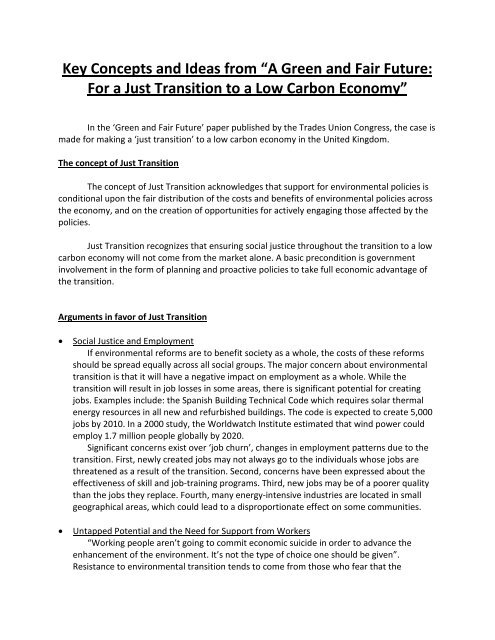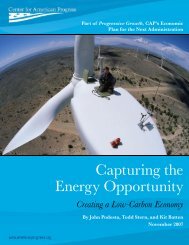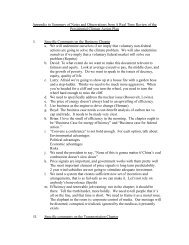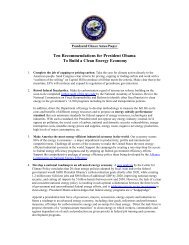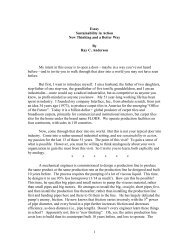A Green and Fair Future: For a Just Transition to a Low Carbon ...
A Green and Fair Future: For a Just Transition to a Low Carbon ...
A Green and Fair Future: For a Just Transition to a Low Carbon ...
You also want an ePaper? Increase the reach of your titles
YUMPU automatically turns print PDFs into web optimized ePapers that Google loves.
Key Concepts <strong>and</strong> Ideas from “A <strong>Green</strong> <strong>and</strong> <strong>Fair</strong> <strong>Future</strong>:<br />
<strong>For</strong> a <strong>Just</strong> <strong>Transition</strong> <strong>to</strong> a <strong>Low</strong> <strong>Carbon</strong> Economy”<br />
In the ‘<strong>Green</strong> <strong>and</strong> <strong>Fair</strong> <strong>Future</strong>’ paper published by the Trades Union Congress, the case is<br />
made for making a ‘just transition’ <strong>to</strong> a low carbon economy in the United Kingdom.<br />
The concept of <strong>Just</strong> <strong>Transition</strong><br />
The concept of <strong>Just</strong> <strong>Transition</strong> acknowledges that support for environmental policies is<br />
conditional upon the fair distribution of the costs <strong>and</strong> benefits of environmental policies across<br />
the economy, <strong>and</strong> on the creation of opportunities for actively engaging those affected by the<br />
policies.<br />
<strong>Just</strong> <strong>Transition</strong> recognizes that ensuring social justice throughout the transition <strong>to</strong> a low<br />
carbon economy will not come from the market alone. A basic precondition is government<br />
involvement in the form of planning <strong>and</strong> proactive policies <strong>to</strong> take full economic advantage of<br />
the transition.<br />
Arguments in favor of <strong>Just</strong> <strong>Transition</strong><br />
• Social <strong>Just</strong>ice <strong>and</strong> Employment<br />
If environmental reforms are <strong>to</strong> benefit society as a whole, the costs of these reforms<br />
should be spread equally across all social groups. The major concern about environmental<br />
transition is that it will have a negative impact on employment as a whole. While the<br />
transition will result in job losses in some areas, there is significant potential for creating<br />
jobs. Examples include: the Spanish Building Technical Code which requires solar thermal<br />
energy resources in all new <strong>and</strong> refurbished buildings. The code is expected <strong>to</strong> create 5,000<br />
jobs by 2010. In a 2000 study, the Worldwatch Institute estimated that wind power could<br />
employ 1.7 million people globally by 2020.<br />
Significant concerns exist over ‘job churn’, changes in employment patterns due <strong>to</strong> the<br />
transition. First, newly created jobs may not always go <strong>to</strong> the individuals whose jobs are<br />
threatened as a result of the transition. Second, concerns have been expressed about the<br />
effectiveness of skill <strong>and</strong> job-training programs. Third, new jobs may be of a poorer quality<br />
than the jobs they replace. Fourth, many energy-intensive industries are located in small<br />
geographical areas, which could lead <strong>to</strong> a disproportionate effect on some communities.<br />
• Untapped Potential <strong>and</strong> the Need for Support from Workers<br />
“Working people aren’t going <strong>to</strong> commit economic suicide in order <strong>to</strong> advance the<br />
enhancement of the environment. It’s not the type of choice one should be given”.<br />
Resistance <strong>to</strong> environmental transition tends <strong>to</strong> come from those who fear that the
transition will damage their livelihoods. Resistance can be removed by involving the<br />
individuals most affected in negotiations <strong>and</strong> the decision-making process. The support of<br />
workers for environmental transition is key. Substantial evidence exists that environmental<br />
transitions happen fastest <strong>and</strong> most efficiently when workers are involved in the transition.<br />
• Economic Return <strong>and</strong> the Benefits of Long-Term Planning<br />
The paper cites the GI Bill as the closest his<strong>to</strong>rical precedent <strong>to</strong> a <strong>Just</strong> <strong>Transition</strong>.<br />
Though many critics labeled the program as <strong>to</strong>o expensive, a 1998 congressional study<br />
found that for every dollar invested in the GI Bill, the government <strong>and</strong> the economy reaped<br />
a minimum of $6.90 in economic growth <strong>and</strong> taxes.<br />
The groundwork for a <strong>Just</strong> <strong>Transition</strong> should include an audit of the skills base<br />
required in a low carbon economy, <strong>and</strong> the establishment of a Stakeholder Advisory Group<br />
<strong>to</strong> provide strategic guidance <strong>and</strong> advice on the skill requirements for the new economy.<br />
The findings of the audit would increase the effectiveness of education programs by<br />
incorporating the results in<strong>to</strong> long-term training <strong>and</strong> staff development programs <strong>and</strong><br />
improve the content of apprenticeships <strong>to</strong> better equip workers for the expected changes<br />
<strong>to</strong> their industry.<br />
The long-term planning at the core of the <strong>Just</strong> <strong>Transition</strong> approach would allow<br />
government <strong>to</strong> make strategic investments in green industries. A key example is the<br />
German Federal Environment Ministry’s adoption of innovation-based environmental policy<br />
centered around a ‘New Deal’ for the economy. Under this approach, the number of jobs in<br />
Germany’s renewable energy sec<strong>to</strong>r increased by nearly 50% between 2004 <strong>and</strong> 2006 <strong>and</strong> is<br />
expected <strong>to</strong> reach 400,000 jobs by 2020.<br />
A second example of a major transition is the Danish wind power industry, which has<br />
recently become Denmark’s third largest exporter. The industry has generated $4 billion<br />
Euros of economic activity, created 20,000 jobs, <strong>and</strong> supplies 16.7% of the country’s energy.<br />
<strong>For</strong> the <strong>Just</strong> <strong>Transition</strong> in the UK, it is proposed that the model be based on five key<br />
principles <strong>and</strong> seven key provisions:<br />
<strong>Just</strong> <strong>Transition</strong> Principles<br />
1. Environmental transition <strong>and</strong> sustainable development.<br />
2. Representation <strong>and</strong> employee/trade union involvement.<br />
3. Stable employment <strong>and</strong> long-term planning.<br />
4. Social <strong>Just</strong>ice <strong>and</strong> a fair distribution of costs.<br />
5. Government backing <strong>and</strong> a united purpose.<br />
<strong>Just</strong> <strong>Transition</strong> Provisions
1. A national framework or mechanism <strong>to</strong> ensure long-term planning <strong>and</strong> representative<br />
decision-making on environmental transition.<br />
2. Education <strong>and</strong> training <strong>to</strong> aid sustainable employment.<br />
3. Decent jobs.<br />
4. Flexible transition packages for workers.<br />
5. Support for communities.<br />
6. Funding.<br />
7. Moni<strong>to</strong>ring <strong>and</strong> further research.<br />
Case studies for further consideration<br />
<strong>Just</strong> <strong>Transition</strong>s undertaken in Spain, Canada, <strong>and</strong> Argentina.


